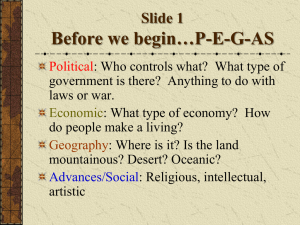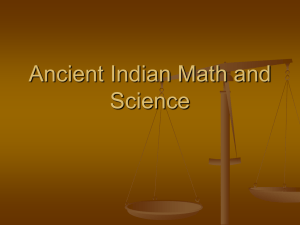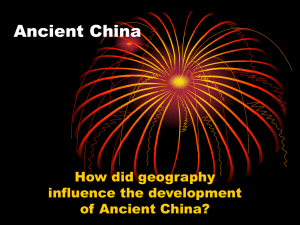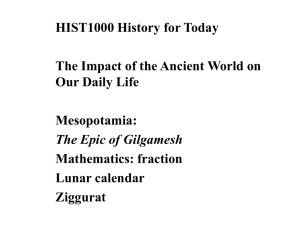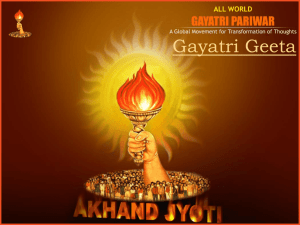Ancient India
advertisement
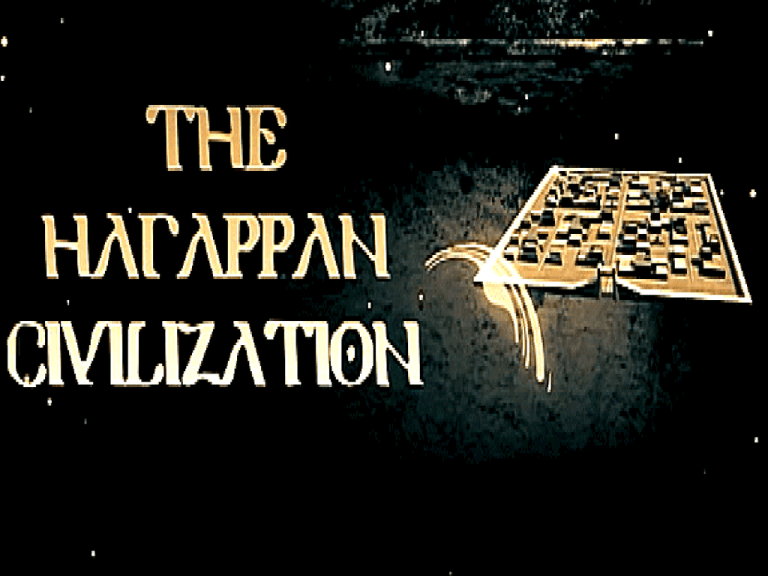
Ancient India Cierra, Sanjana and Hubert S.P.R.I.T.E (Social) Ancient India was composed of four main social classes and within those classes contained castes. People born in these social classes could not leave these classes. These social classes were composed of people like priests, warriors, farmers and those below them. Outside all of these people were the “Untouchables” which were excluded. S.P.R.I.T.E (Social cont.) *Mohenjo-Daro* S.P.R.I.T.E (Social cont.) Building Architecture & Infrastructure: The ancient houses has early sanitation systems, access to city water, were about the same size and were made of dry bricks. There was also citadels used for defending these settlements. A noticeable characteristic is that there is no high built buildings. These settlements are set up with a wall around the perimeter used to regulate trade, defense and protection against floods. S.P.R.I.T.E (Political) Ancient India had tribal style governments with a king or Raja as the leader. Essentially there were many small republics with the Raja as the leader of everything that could have been advised by council men. S.P.R.I.T.E (Religious) Hindus made up 70% of the Ancient Indus civilization helped organize education, social standing and daily living. Religions such as Hinduism, Buddhism and Jainism gained many followers in Ancient India. Ramayana and Mahabharata were one of the two great epics of Hinduism. Story Time The Birds and the Shivering Monkeys This is another interesting tale/ story from the collection of Hitopadesha Tales. Once upon a time, there was a huge tree on the banks of a river. The tree made a comfortable home for the family of birds who had built their nests on its branch. The birds were living there happily as the tree with its widespread branches sheltered them from scorching sun and heavy rains. One day, when the sky was overcast with dark clouds, it rained very heavily. Some monkeys who were playing nearby the tree got drenched and ran for shelter under the tree. All of them were shivering with cold. When the birds saw the monkeys in the pitiable condition, one of the birds said,” O Monkeys, you would not have to shiver like this, if you had built a home like us. You would not have to suffer like this. If we can build our nest with small beaks, then why cant you. By God’s grace, you have two hands and two legs. Why don’t you make a nice shelter for yourselves?” On hearing this, the monkeys got annoyed and swore to teach a lesson to the birds. They said to themselves, “These birds are not afraid of the rain or of cold wind. They are living comfortably that is why they are criticizing us like this. Let the rain stops, we’ll show them how to build home”. As soon as the rain stopped, the monkeys climbed up the tree and destroyed the nests of the birds. They also broke the birds’ eggs and threw the young ones down. The poor birds flew here and there in misery. They were full of regret for their words and realized that they should not have given advice that was not asked. Advice should only be given to learned, wise and to those who ask for it. Moral: Never give advice to fools. *Acquired from http://www.culturalindia.net/indian-folktales/hitopadesha-tales/birds-and-shivering-monkeys.html* S.P.R.I.T.E (Intellectual) The Ancient Indians intensely studied mathematics, religion, philosophy and writing. Ancient India was the only civilization at that time that didn’t have slavery. Peaceful philosophies such as a unique sense of peace and harmony stemmed from Ancient India. S.P.R.I.T.E (Technological) The letters of the Indus alphabet were arranged in a systematic way These letters were classified due to the location of the sound in the vocal cords The Ancient Indians also invented the first precise measuring system. As well as the most precise measurement tools. S.P.I.T.E (Technology Conti.) Sanskrit S.P.R.I.T.E (Economic) The Indus civilization focused on agriculture and trade. Due to the location of the Indus Valley trading was done from near and far. There was trading from Central Asia, the Arabian Peninsula and Mesopotamia. Besides agriculture many people created pottery, jewelry, metal work and weaponry. Work Cited Works Cited "Ancient India Government." - Government In Ancient India. N.p., n.d. Web. 07 Feb. 2014. "Ancient Man and His First Civilizations." The Indus Valley: The Beginnings of Indian Culture -. N.p., n.d. Web. 07 Feb. 2014. "Contribution of India to the World - (Gayatri Mantra,Vedas,Scientific Spirituality, AWGP)." Contribution of India to the World - (Gayatri Mantra,Vedas,Scientific Spirituality, AWGP). N.p., n.d. Web. 07 Feb. 2014. "Harappan (Indus Valley) Civilization | Harappa and Mohenjo Daro Excavations - Ancient Indian History." YouTube. YouTube, 28 May 2012. Web. 07 Feb. 2014. "Indian Folktales." - Folk Tales of India, Indian Folklore, Folk Tales from India. N.p., n.d. Web. 07 Feb. 2014. "INDUS RIVER VALLEY CIVILIZATION." Indus River Valley Civilization. N.p., 12 Sept. 2011. Web. 05 Feb. 2014. Ramírez, Susan E., Peter N. Stearns, Samuel S. Wineburg, and Steven A. Goldberg. "Chapter 4 Ancient India and China." Holt World History: Human Legacy. Austin, TX: Holt, Rinehart and Winston, 2008. N. pag. Print.



